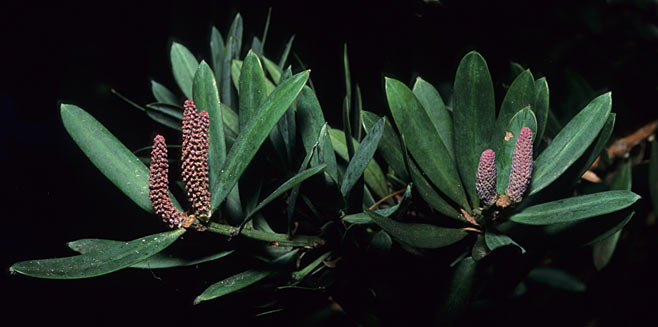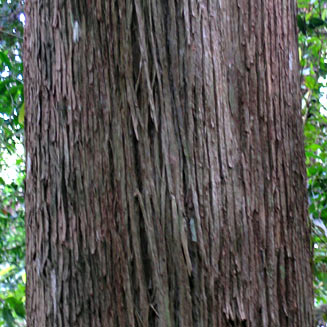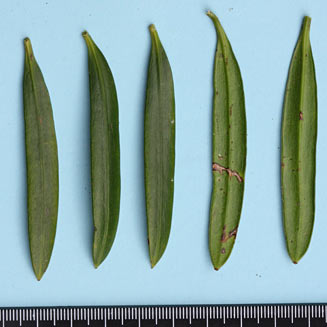|
Podocarpus latifolius (Real yellowwood)
Opregte geelhout [Afrikaans]; umSonti, umKhoba, umGeya [Xhosa, Zulu. The term
umGeya is used also for the Outeniqua yellowwood as well as for the giraffe!];
Monyaunyau, Mogobagoba [North Sotho]; Muhovho-hovho [Venda]
Life
> eukaryotes >
Archaeoplastida >
Chloroplastida
>
Charophyta > Streptophytina > Plantae (land plants)
> Tracheophyta (vascular plants) > Euphyllophyta > Lignophyta (woody plants) > Spermatophyta (seed plants)
> Gymnospermae >
Coniferophyta
> Podocarpaceae
> Genus: Podocarpus
 |
|
Podocarpus latifolius with male cones, in Arderne Gardens, Cape
Town. [photo H. Robertson, Iziko ©] |
 |
 |
|
Podocarpus latifolius trunk; Outeniqua
Hiking Trail, December 2008. [photo H. Robertson
©] |
Leaves of Podocarpus latifolius: upperside
(3 on left) and underside (2 on right); Outeniqua Hiking Trail, December
2008. [photo H. Robertson ©] |
Distribution and habitat
Occurs in Afromontane and Coastal forests in the Western
Cape, Eastern Cape, KwaZulu-Natal, Swaziland, Mpumalanga, Limpopo and in the
Eastern Highlands of Zimbabwe extending into adjacent areas of Mozambique.
Uses
- The pale-yellow, fine-grained wood is used mainly for making
furniture. It becomes a deaper yellow colour with age. In earlier times it
was also used for flooring and roof beams and can still be seen in some of
the old Cape homesteads. The wood often has a spiral grain that can make it
warp although proper seasoning helps to prevent this from happening. It was
also used previously for railway sleepers although being a soft wood, it
rots easily in contact with the soil - creosoting the wood helped to prevent
such deterioration. According to Palmer and Pitman (1972), Real yellowwood
has yielded more timber than any other indigenous tree [in South Africa]
although today there is much more careful control over exploitation of this
tree.
- Grown as a garden ornamental tree.
References
- Palgrave, K.C. and Palgrave, M.C. 2002. Trees of Southern Africa.
3rd Edition. Struik Publishers, Cape Town.
- Palmer, E. and Pitman, N. 1972. Trees of Southern Africa covering
all known indigenous species in the Republic of South Africa, South-West
Africa, Botswana, Lesotho and Swaziland. Volume 1. A.A.
Balkema, Cape Town.
- van Wyk, B. and van Wyk, P. 1997. Field Guide to Trees of
Southern Africa. Struik Publishers, Cape Town.
Text by Hamish Robertson |
